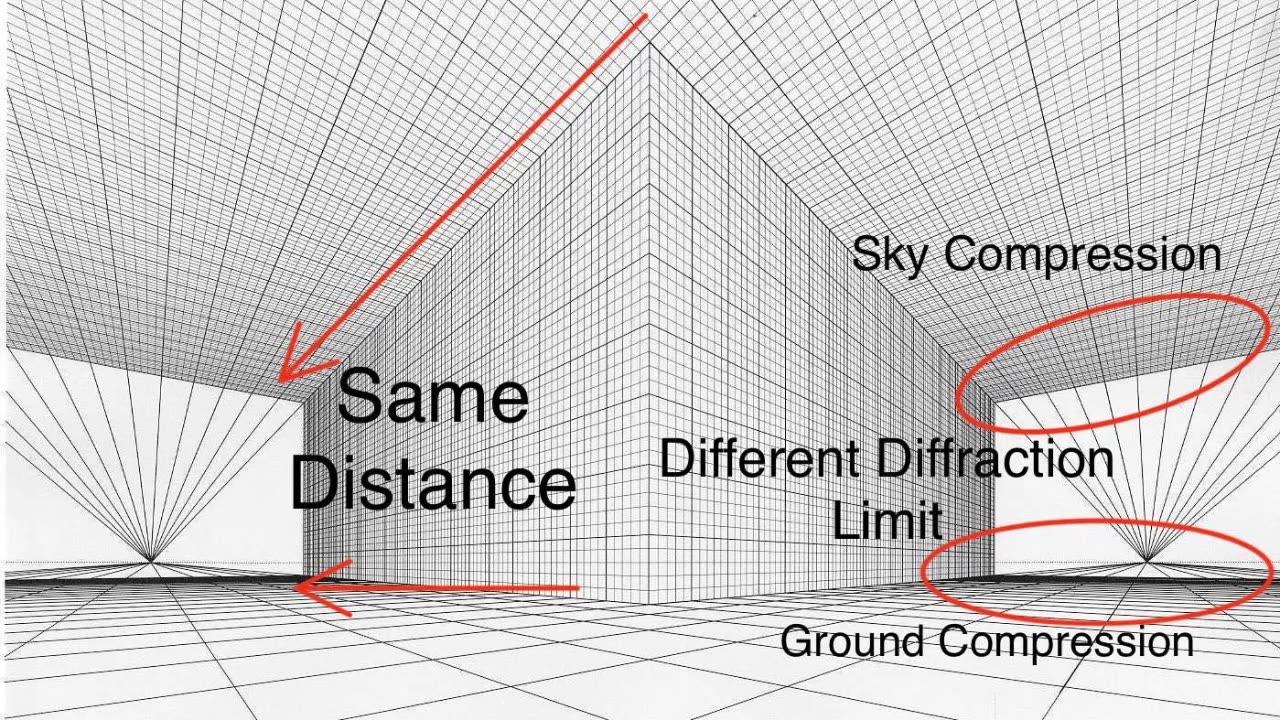Premium Only Content

If the Earth was flat, How could the Sun set?
If the Earth was flat, How could the Sun set?
The Sun never sets.... it only moves far enough away to become unresolvable, and eventually takes its daylight with it.
Perspective, observer height, the diffraction limit, the attenuation of light, and angular resolution limit all contribute to the visual phenomenon of objects appearing to disappear bottom-up at a distance.
The eye's resolution angle, which is the minimum angle at which two points can be distinguished as separate, also plays a crucial role in the perception of objects at a distance. An example involving two equal-sized balls at a given distance [pictured below], one above the observer's line of sight appears smaller as it moves away, while the one below appears larger. They also illustrate that there is a specific angle at which objects disappear from sight, referred to as Θ (theta), and this angle is reached sooner for objects below the eye line.
Keep in mind that for the object to disappear entirely, or become completely unresolvable, theta must be diminished to zero both above and below.
The images below illustrate how angles of sight compress or expand based on the observer's height and how objects of different heights are perceived by the human eye. They convey that as an observer lowers their height, the angles close to the ground compress, making the horizon appear closer. Changing the observer's height affects the angles of sight, compressing them more at the bottom (ground level) than at the top (sky level). This alteration results in a change in how information is visually processed and how far one can see. Conversely, the angles above expand. An object traveling at a higher altitude would show little change in angular size before it sets into the lower horizon. Although the total number of potential angles of vision above and below the eye line is the same, the compression rate of these angles differs. This variance in compression affects how objects are visually perceived as they move away from the observer.
Objects can seem to disappear or "set" into the horizon or other larger objects (like buildings) when viewed from certain angles. When one looks up at a very steep angle, the floors towards the top of a building compress visually, making it harder to discern details or even see the highest floors. This compression of angles leads to a loss of information and contributes to the "disappearance" of objects that are not actually obscured by any physical barriers. Also, there are of course atmospheric conditions such as aberrations and refraction that can alter the perceived size and shape of distant objects.
The higher the ceiling, the steeper the angular compression, and the faster the descent rate to the vanishing line.
This is EXACTLY how the sun and moon appear to set, maintaining a relatively constant size due to their high upper boundary and short travel distance within the observer's perspective before they meet the horizon line.
Taller objects, those exte
-
![Addressing Jeran's Globe Proofs 2 [The South Celestial Pole]](https://1a-1791.com/video/fww1/84/s8/1/F/_/c/y/F_cyy.0kob-small-Addressing-Jerans-Globe-Pro.jpg) 12:57
12:57
Anti-Disinfo League
8 days agoAddressing Jeran's Globe Proofs 2 [The South Celestial Pole]
282 -
 LIVE
LIVE
LFA TV
21 hours agoLFA TV - ALL DAY LIVE STREAM 4/9/25
865 watching -
 2:05:32
2:05:32
The Quartering
4 hours agoTrump Says "Be Cool" (It Works), China Tries HUMILATING America (It Doesn't)
181K47 -
 1:19:52
1:19:52
The HotSeat
2 hours agoSocial Media Is the New Drug — And Your Kids Are Addicted
4.98K2 -
 1:25:05
1:25:05
Russell Brand
5 hours agoTrade War Inferno: Trump Torches China with 124%—Xi Hits Back Hard – SF563
192K37 -
 47:29
47:29
Sean Unpaved
5 hours agoMike Malone's Shocking Departure From Denver! & Masters Tournament Favorites
84.3K1 -
 2:21:41
2:21:41
Keepslidin
2 hours ago5K START | ROAD TO 100K | Mother.land
10.1K1 -
 1:03:12
1:03:12
Timcast
5 hours agoChina RETALIATES With 84% Tariff, Trump REFUSES To Surrender, Gen Z IN CRISIS
231K161 -
 1:11:04
1:11:04
Jeff Ahern
2 hours agoNever woke Wednesday with Jeff Ahern! (1pm Pacific)
11.1K -
![[Ep 646] Eagle vs. Dragon: Trade War Throwdown | Pre-Crime: Real or Si-Fi? | Border Update](https://1a-1791.com/video/fww1/c0/s8/1/L/P/L/A/LPLAy.0kob-small-Ep-646-Eagle-vs.-Dragon-Tra.jpg) LIVE
LIVE
The Nunn Report - w/ Dan Nunn
2 hours ago[Ep 646] Eagle vs. Dragon: Trade War Throwdown | Pre-Crime: Real or Si-Fi? | Border Update
193 watching